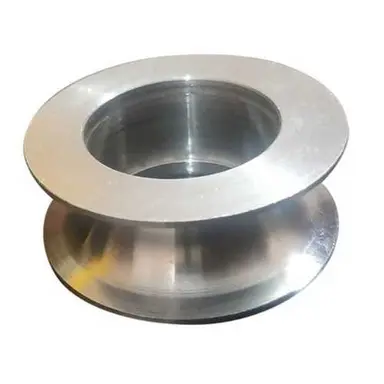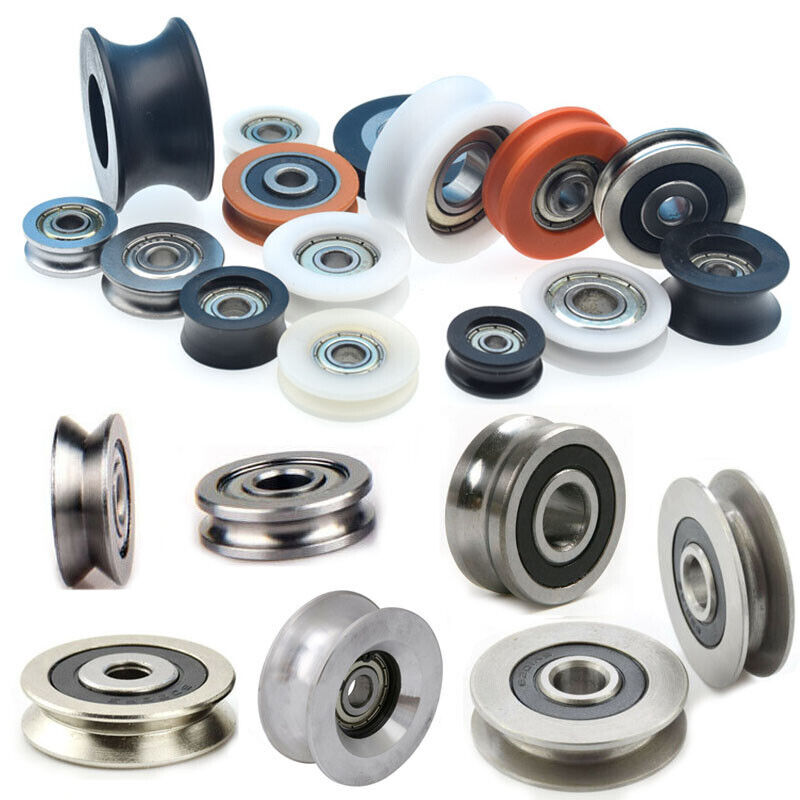Product Description
Company Profile:
HangZhou CHINAMFG Hardware Products Co., Ltd. is a professional manufacturer of CHINAMFG Hardware since 2571. Our products are mainly used for Sliding Gates, Swing gates, Cantilever Gates, Wooden CHINAMFG & Industrial Gates. Such as sliding gate wheels, nylon rollers, brackets, latches, guide wheels, ground tracks, hinges, door stoppers, etc. We have been working in this industry for more than 10 years. We are growing very fast based on the respect of quality standard, perfect service, fast delivery and continuous innovation. Our products have been covering over 40 countries & area , like Australia, New Zealand, Poland, Hungary, Slovakia, France, UK, Russia, USA, Argentina, India, etc. And always attain good reputation from our customers.
Chance favors only the prepared mind ! We are always ready to offer best service to every customer. We warmly welcome you to visit our company.
Product Description:
Hanging Roller,
used for sliding door.
We have size 25mm, 38mm, 44mm and 54mm.
Warmly welcome to send us inquiry to ask for details.
Production Capacity:
Some other items we make:
/* January 22, 2571 19:08:37 */!function(){function s(e,r){var a,o={};try{e&&e.split(“,”).forEach(function(e,t){e&&(a=e.match(/(.*?):(.*)$/))&&1
| Certification: | TUV |
|---|---|
| Splittable: | Splittable |
| Surface Treatment: | Zinc Plated |
| Material: | Metal |
| Usage: | Sliding Door |
| Color: | Silver |
| Samples: |
US$ 5/Piece
1 Piece(Min.Order) | |
|---|
| Customization: |
Available
| Customized Request |
|---|

How do you select the right roller pulley configuration for a specific material handling task?
Selecting the right roller pulley configuration for a specific material handling task involves considering several factors to ensure optimal performance and efficiency. Here are the key steps in the selection process:
- Identify Material Characteristics: Begin by understanding the characteristics of the materials being handled. Consider factors such as weight, size, shape, fragility, and surface properties. For example, heavy or bulky materials may require roller pulleys with higher load capacities, while fragile items may necessitate the use of cushioned or impact-resistant rollers.
- Determine Conveyor Layout: Evaluate the layout and configuration of the conveyor system. Take into account factors such as straight sections, curves, inclines, declines, or any specific requirements for diverting or merging materials. Different roller pulley types, such as tapered rollers or grooved rollers, may be needed to accommodate specific layout features and ensure smooth material flow.
- Consider Operational Environment: Assess the operational environment in which the roller pulleys will be used. Take into account factors such as temperature, humidity, presence of dust or debris, and exposure to corrosive substances. Some environments may require roller pulleys with special coatings or materials to withstand harsh conditions and prevent damage or premature wear.
- Calculate Load Capacity and Speed: Determine the load capacity and desired speed of the conveyor system. This involves considering the weight and volume of the materials being transported, as well as the desired throughput. Select roller pulleys that can handle the anticipated load while maintaining efficient operation and preventing excessive wear.
- Consider Special Requirements: Assess any special requirements or constraints specific to the material handling task. For example, if the task involves strict hygiene standards, roller pulleys made of materials suitable for cleanroom environments may be necessary. If noise reduction is a concern, selecting roller pulleys with noise-dampening features can be beneficial.
- Consult Manufacturer Guidelines: Consult the guidelines and recommendations provided by roller pulley manufacturers. They often provide technical specifications, load capacity charts, and application guidelines for different roller pulley configurations. Manufacturers can offer valuable insights and expertise in selecting the most suitable roller pulleys for specific material handling tasks.
By following these steps and considering the specific requirements of the material handling task, it becomes possible to select the right roller pulley configuration. This ensures optimal performance, longevity, and efficiency in material handling operations.

How do roller pulleys contribute to the efficiency and productivity of material handling operations?
Roller pulleys play a crucial role in enhancing the efficiency and productivity of material handling operations in conveyor systems. Here are the ways in which roller pulleys contribute to these aspects:
- Smooth Material Flow: Roller pulleys provide a smooth surface for the conveyor belt to move on, minimizing friction and allowing materials to flow seamlessly. The low rolling resistance offered by roller pulleys reduces the energy required to transport materials, resulting in improved efficiency and optimized power consumption.
- Reduced Manual Effort: By utilizing roller pulleys, manual effort in material handling operations is significantly reduced. The rollers support the weight of the materials and facilitate their movement along the conveyor, eliminating or minimizing the need for manual pushing or lifting. This reduces physical strain on workers, increases their productivity, and lowers the risk of injuries.
- Flexibility and Versatility: Roller pulleys offer flexibility and versatility in material handling operations. They can be designed and configured to accommodate various conveyor layouts, including straight sections, curves, inclines, and declines. This adaptability allows for efficient material transfer across different areas of a facility or between different stages of a production process.
- Accurate Sorting and Distribution: Roller pulleys are often used in sorting and distribution applications, where precise and controlled movement of materials is required. By incorporating specialized rollers, such as tapered rollers or diverter rollers, conveyor systems can accurately divert, merge, or sort materials based on predetermined criteria. This improves the accuracy and speed of sorting operations, leading to enhanced productivity and throughput.
- Increased Throughput: Efficient material handling facilitated by roller pulleys results in increased throughput. The smooth movement of materials, reduced bottlenecks, and optimized flow contribute to higher processing speeds and improved overall production capacity. Conveyor systems with properly designed roller pulleys can handle larger volumes of materials, allowing for faster and more efficient material handling operations.
- Automation Integration: Roller pulleys are compatible with automation technologies, such as sensors, controllers, and robotic systems. This enables the integration of conveyor systems with automated material handling processes. By incorporating roller pulleys into automated systems, tasks such as material loading, unloading, sorting, and packaging can be streamlined and performed with high precision, further enhancing efficiency and productivity.
In summary, roller pulleys contribute to the efficiency and productivity of material handling operations by enabling smooth material flow, reducing manual effort, providing flexibility and versatility, facilitating accurate sorting and distribution, increasing throughput, and supporting automation integration. These benefits make roller pulleys an essential component in optimizing material handling processes across various industries and applications.

In which industries and applications are roller pulleys commonly used?
Roller pulleys are widely used in various industries and applications where there is a need for efficient material handling and movement. Here’s a detailed explanation:
Industries:
1. Manufacturing and Production: Roller pulleys are extensively used in manufacturing and production industries for conveyor systems that transport materials and products along assembly lines. They facilitate the smooth movement of items during processes such as sorting, packaging, and assembly.
2. Mining and Quarrying: Roller pulleys are commonly employed in mining and quarrying operations to transport bulk materials such as ores, coal, gravel, and sand. They are essential components in conveyor systems that facilitate the efficient extraction and transportation of mined materials.
3. Warehousing and Distribution: Roller pulleys play a crucial role in warehousing and distribution facilities, where they are used in conveyor systems to move goods, packages, and pallets. They enable efficient material flow, sorting, and loading/unloading operations in warehouses and distribution centers.
4. Agriculture and Food Processing: Roller pulleys are utilized in the agricultural sector for handling crops, grains, and feed. In food processing plants, they are essential for conveying and processing various food products such as fruits, vegetables, baked goods, and beverages.
5. Automotive and Aerospace: Roller pulleys find applications in the automotive and aerospace industries for assembly lines and material handling systems. They are used to transport components, parts, and finished products during manufacturing processes, ensuring smooth and efficient production operations.
6. Construction and Building Materials: Roller pulleys are employed in the construction industry for handling building materials such as concrete blocks, bricks, lumber, and pipes. They are utilized in conveyor systems for efficient material transport and placement at construction sites.
Applications:
1. Conveyor Systems: Roller pulleys are a fundamental component of conveyor systems used in various industries. They facilitate the movement of materials along belts or chains, enabling efficient material handling, sorting, and transportation.
2. Material Handling: Roller pulleys are used in applications involving manual or automated material handling, such as loading/unloading operations, pallet handling, and material transfer between different processing stages.
3. Sorting and Distribution: Roller pulleys are employed in sorting systems that separate items based on criteria such as size, weight, or destination. They enable precise and controlled movement of items along sorting lines.
4. Accumulation and Storage: Roller pulleys with built-in braking mechanisms are utilized in applications that require accumulation and storage of materials or products. They allow for controlled stopping and accumulation of items before further processing or distribution.
5. Power Transmission: In some applications, roller pulleys are used as part of power transmission systems, where they transfer rotational motion and power between different components or machinery.
6. Automated Guided Vehicles (AGVs): Roller pulleys are integrated into AGVs, which are autonomous vehicles used for material transport in industries such as warehousing, manufacturing, and logistics. The rollers enable smooth movement of the AGVs and efficient transfer of materials.
In summary, roller pulleys are commonly used in industries such as manufacturing, mining, warehousing, agriculture, automotive, aerospace, and construction. They find applications in conveyor systems, material handling, sorting and distribution, accumulation and storage, power transmission, and automated guided vehicles. Roller pulleys play a vital role in facilitating efficient material movement, improving productivity, and streamlining operations in a wide range of industries and applications.


editor by CX
2024-04-12